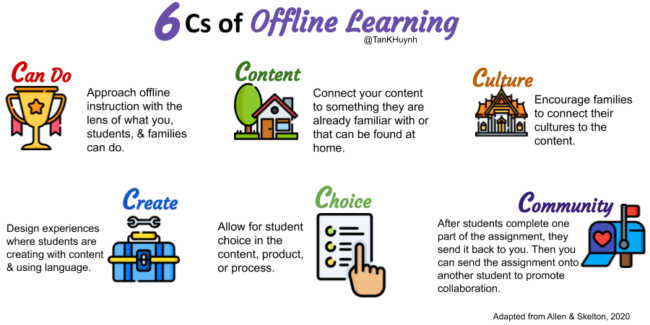School closures have made learning more challenging. For students without access to technology, this challenge might seem insurmountable. How can we reach distance learners who don’t have regular access to technology or the internet?
Yet, I keep hearing stories of teachers continuing to support language learners who have no access to technology and doing it well. As I learn about their stories and approaches, similarities emerge. I have organized these similarities into what I call the 6 Cs of Offline Learning based on my podcast interview with consultants, Beth Skelton and Dr. Mia Allen.
Can Do
We can start with a positive attitude as it is the lens through which we can look at all offline instruction. If you focus on all the things that are barriers, you might become too discouraged to even consider the opportunities.
Take a handful of rocks, for example. What are all the ways you can use them? You might use them as paperweights, door stoppers, counting tools, trail markers, or characters in a story. But if you only think of them as rocks, they will always only be rocks. This analogy helps me remember that we are trapped by our can’ts and freed by our cans.
Content
Students need content to use language for authentic purposes. We have to be creative to think about how to get students to understand content when we are not physically there.
For example, let’s say you want to teach your students about ecosystems, and your students live in a rural community. Ask them to go to a patch of grass and get real close. Then, ask them to draw everything they see, such as soil, insects, weeds, stones, flowers, or fallen branches.
To teach content, think about the context most of your students may be familiar with. Then, try to have students find the content that’s already in their lives.
Culture
Students’ cultural heritage holds the greatest potential for connection to content. Let’s return to the ecosystem lesson. You could have your students ask their family to tell them about an animal from their home country. Even if they’re not from a different country, maybe they’re from a different state, neighborhood, or town. First, have the student draw the animal. Then, have them draw all the things in the environment that that particular animal needs to survive. If possible, you might even have the family help label everything in that picture in their home language.
The important thing about culture is to have the family contribute from their backgrounds and funds of knowledge. In this way, we want to partner with families, validate their experiences, and empower them to participate in their child’s learning.
Create
Similar to when students are in a physical school, they learn content and develop language skills most when students actively engage with the standards. This means we have to design learning that requires students to do something with content and language, especially when we are not there to teach it to them.
In the previous examples, we had students draw, but we could also have students pantomime all the nonliving and living things in an ecosystem as a form of active engagement (Ecehvarría, Vogt, & Short, 2017).
Choice
Closely linked to create is student choice. Again returning to the ecosystem example, you could provide a labeled picture of a patch of grass. In the instructions, let students choose a small plot of land (it does not have to be a patch of grass). Students can choose a potted plant, the grassy area next to a bus stop, or even a park path. The important thing is to provide students with as much freedom to choose as possible. This autonomy will garner more student engagement. (Ferlazzo & Hull, 2018).
Community
Fostering a sense of community is still possible offline, but it will, unfortunately, move at the pace of mail service. Returning to the ecosystem drawings, I could have my students create an animal drawing without the labels. Each student could mail back that drawing sealed in an envelope you provided students in their package. You then could send each student a drawing from one of their classmates.
Students would now have to label all the non-living and living items on their friends’ drawings. They would send this labeled drawing back to you, and then you would send it back to the original student. This example shows how you can intentionally design learning experiences where students are building on each other’s ideas and interacting asynchronously.
It does not matter the pace at which you build a sense of community. What matters most is students realizing that they are part of a learning community. While they are learning in separate locations, they learn that they are not learning alone.
Students who do not have access to technology still have access to the most important aspect of school: you, their loving teachers. You and I determine the experience students have as they learn from home. With this framework, we can to design enriching learning opportunities because we focus on what can be done rather than become paralyzed by what we cannot control.
Though these principles are for teachers to use to support students without access to technology, when we step back, we see that these principles are just things we do to make learning student-centered. Therefore, though you might use these now in this distance learning context, we encourage you to bring them back to influence your in-person instruction when schools reopen.
Echevarria, J., Vogt, M. E., & Short, D. J. (2017). Making content comprehensible for English learners: The SIOP Model. Boston: Pearson.
Ferlazzo, L., & Hull-Sypnieski, K. (2018). The ELL teachers toolbox: Hundreds of practical ideas to support your students. San Francisco: Jossey-Bass.


